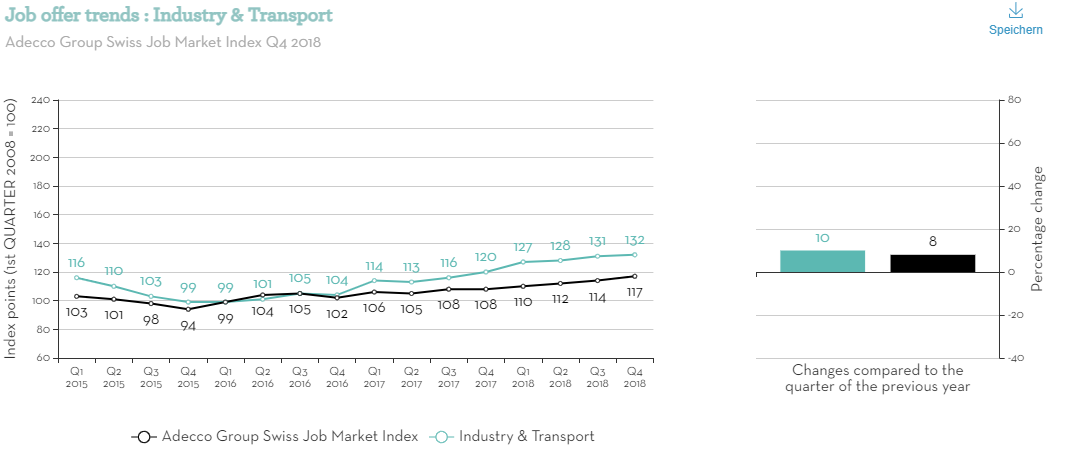Swiss job market in high gear despite reserved economic forecasts
Zurich, 17 January 2019 – Swiss companies advertised 8% more jobs in the fourth quarter of 2018 than they did in the previous year, with job market vacancies remaining at a very high level. This is reflected in the scientifically substantiated survey of the Adecco Group Swiss Job Market Index conducted by the Swiss Job Market Monitor from the University of Zurich. Almost all job groups saw growth, although to varying degrees. The number of job advertisements also increased throughout the major Swiss regions compared to the previous year. The greatest gains were made in the Lake Geneva Region with an increase of 18%, while Eastern Switzerland and the Espace Mittelland both saw gains of 14% in a year-on-year comparison. The upswing on the job advertisement market also continued to the end of 2018.
The Adecco Group Swiss Job Market Index achieved growth of 8% in the fourth quarter of 2018 compared to the previous year. With an increase of 2%, the current job index remains overall stable compared to the previous quarter. “Despite reserved positive economic forecasts for 2019, companies were still looking for more staff at the end of the year. This enabled the Swiss job market to display extremely positive growth throughout all of 2018. The job index’s annual average in 2018 was 6% higher than in 2017. This reflects the strong growth compared to the previous annual averages since 2014,” commented Nicole Burth, CEO of the Adecco Group Switzerland.
Increased staffing demands in organisational and management professions along with IT occupations, but also in the occupational group of teaching and public service 
The number of job advertisements in the teaching and public service professions (e.g. teachers or educators) also rose during the winter quarter with growth of 15% compared to the previous year and with growth of 10% compared to the previous quarter. “We predict that based on the growing number of school-aged children in most age groups, more teaching staff in general will be required,” added Anna von Ow from the Swiss Job Market Monitor.

REGIONS
Lake Geneva Region continues its surge
Thanks to the current growth, the increase in job postings in the Lake Geneva Region continued all the way to the end of 2018: Job advertisements rose 18% during the current winter quarter compared to the previous year. This means that the region has now seen more than two years of gains. When compared on a quarterly basis, the region’s growth remains stable in general at a high level (+4%). All of the occupation groups were able to gain jobs in a year-on-year comparison. The staffing demand for the occupational groups in industry and construction saw above-average growth of 29%, whereby the increase was fuelled above all by jobs in construction and renovation. We assume that the ongoing infrastructure projects in the occupational group of transportation, along with the pull of the urban centres, have contributed to this strong performance.
.png?h=550&iar=0&w=1080&sc_lang=en-ch&hash=63813D209982C424C9E2E9F340AFFD8D)
Northwestern Switzerland, the Greater Zurich Area (4% growth in each), and Central Switzerland (+3%) are currently advertising a similar number of jobs as last year. Very little has changed here compared to the previous quarter as well.
Importance of print media as advertising channel sinks dramatically
According to our company surveys, print media now has almost no relevance when it comes to advertising job vacancies. As a result, as of the second quarter of 2018, the number of job advertisements published in the print media will no longer be factored into the calculations of the job index.
GRAPHICS
Entwicklung Stellenangebot nach Berufen Entwicklung Stellenangebot nach Grossregionen Entwicklung Stellenangebote nach Berufen Gesamtindex und Teilindices
Note regarding data collection: Optimisation
Based on revisions to the Adecco Group Job Market Index, some of the figures listed in this media release differ slightly from the figures published earlier. The revisions serve to align the index with a constantly changing job market. They pertain above all to the regional allocation of advertisements, the allocation of individual job titles to job groups, and the multiple publication of job advertisements. The revisions are intended to optimise the index, and therefore do not render the earlier published figures invalid in any way.
